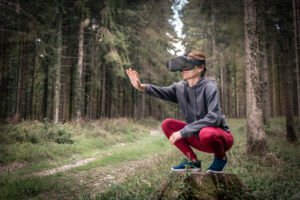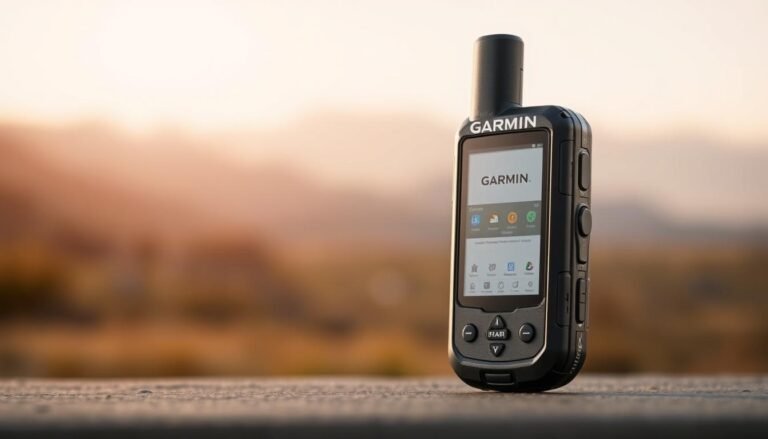The Intelligent Trail: How AI for Hiking Is Revolutionizing Outdoor Safety
The future of hiking is here: #AI4Hiking tech is revolutionizing outdoor safety and enhancing the trail experience.
Every year, over 20,000 hikers encounter emergencies in U.S. national parks. AI for hiking is transforming this landscape. By analyzing weather, terrain, and user data, it prevents accidents before they occur.
Now, tools like real-time trail alerts and risk assessments are common in hiking. These technologies identify unstable ground or sudden storms, directing hikers to safer routes instantly.
Explore how AI for hiking converts data into survival tools. From wearable devices to trailside alerts, this piece uncovers the innovation reshaping outdoor safety.
Introduction to AI for Hiking and Its Impact
Artificial intelligence hiking tools are revolutionizing the preparation and navigation of outdoor adventures. These technologies leverage data analysis to improve safety and decision-making processes. They offer real-time insights on trail selection and weather monitoring, previously inaccessible to most adventurers.
Understanding AI Integration
AI integration is facilitated through apps and wearable devices that gather user data. For instance, they analyze trail difficulty, weather patterns, and hiker fitness levels to suggest optimal paths. Companies like Gaia GPS and AllTrails employ machine learning algorithms to provide personalized recommendations, thereby reducing risks associated with unexpected terrain changes.

Benefits for Hiker Safety
Key safety benefits include:
- Predictive weather alerts that detect storms hours before they strike
- Automated trail condition updates shared in real time
- Emergency location tracking via GPS-enabled smartwatches
Studies indicate that AI tools can cut down rescue response times by 40% in backcountry areas. AI-optimized gear, such as temperature-regulating jackets and terrain-adaptive boots, also boosts physical safety in extreme conditions.
These advancements do more than prevent accidents; they empower hikers to make informed decisions. By analyzing past incidents and environmental factors, artificial intelligence hiking tools establish a proactive safety net for outdoor enthusiasts.
The Evolution of Outdoor Safety Technology
In the early days, hikers depended on physical maps and compasses to navigate. These tools demanded skill and memorization to prevent getting lost. With the advent of GPS devices from brands like Garmin and Suunto, paper maps became obsolete. These devices offered real-time location tracking and route planning, revolutionizing navigation.
Today, smart hiking technology has evolved significantly. AI-driven apps now analyze weather patterns and trail conditions, delivering personalized safety alerts. Platforms like AllTrails and Gaia GPS leverage AI to forecast hazards and recommend safer routes. Additionally, wearables equipped with AI monitor vital signs, alerting users to potential risks early on.
This progression underscores the continuous improvement in smart hiking technology. From rudimentary tools to sophisticated AI-powered devices, each step emphasizes safety and ease of use. As technology evolves, these innovations continue to reshape how hikers prepare and navigate the great outdoors.
Innovative Hiking AI Gadgets Shaping the Trails
Modern hiking ai solutions are revolutionizing wilderness exploration. Smart devices, equipped with sensors, GPS, and machine learning, are being developed. These tools adapt to trail conditions and user needs, going beyond mere tracking. They anticipate challenges and enhance safety.
Smart Hiking Technology Explained
At the heart of this technology are motion sensors, environmental detectors, and real-time data processing. AI analyzes inputs such as temperature, elevation, and user movement. It provides actionable insights, predicting weather shifts or risky terrain and sending alerts to hikers’ devices.
AI-Powered Outdoor Gear Innovations
Leading brands are introducing groundbreaking products:
- Garmin inReach Mini 2: Employs AI to send SOS signals and update trail maps dynamically.
- Suunto 9 Peak: Integrates AI to optimize routes based on hiker stamina and trail conditions.
- Gaia GPS: Features AI-driven terrain analysis, suggesting safer paths in real time.
Adaptive clothing and smart backpacks are also on the horizon. Hiking ai solutions now include gear that monitors hydration levels or adjusts insulation based on weather predictions. These tools transform raw data into actionable guidance, ensuring safer and more efficient trips.
Artificial Intelligence Hiking Tools Empowering Adventure
Modern AI tools are revolutionizing the way adventurers prepare for the wilderness. Apps such as AllTrails and Komoot leverage hiking with ai assistance to analyze user preferences, weather, and trail conditions. These systems generate customized itineraries, ensuring hikers align routes with their skill levels and objectives.
Virtual trail scouting platforms highlight potential hazards or scenic spots. Real-time gear recommendations adjust for temperature changes. Groups benefit from AI-driven route optimization, synchronizing paths for diverse skill levels. For example, Gaia GPS’s AI predicts trail difficulty based on hiker data, reducing navigation errors.
- Personalized Route Planning: AI analyzes user data to suggest trails matching fitness and interests.
- Real-Time Adjustments: Tools like REI’s Co-op Navigator update paths if weather or terrain changes.
- Group Coordination: Apps sync multiple hikers’ needs, ensuring cohesive group journeys.
Backcountry explorers gain access to thermal maps and wildlife activity alerts, enhancing safety without sacrificing spontaneity. These innovations make hiking with ai assistance accessible, bridging the gap between technology and tradition. From gear suggestions to emergency protocols, AI ensures every step is informed and intentional.
Enhancing the Trail Experience Through Technology
Modern ai-powered outdoor gear merges adventure with innovation, transforming hiking into a seamless experience. Real-time updates and adaptive tools guide hikers with precision. This ensures every journey is safer and more intuitive.
Real-Time Navigation and Alerts
Navigation apps like Gaia GPS and devices such as Garmin’s inReach Mini 2 provide live trail maps and hazard warnings. These systems analyze weather patterns and trail conditions, sending alerts for sudden storms or unsafe paths. For instance, AllTrails’ app updates routes based on real-time user reports, automatically rerouting hikers around blocked paths.
- Weather alerts: Wind, rain, or temperature drops
- Terrain updates: Landslides, mudslides, or trail closures
- Location sharing: Emergency SOS features for rescue coordination
Personalized Hiking Assistance
AI-driven gear like Komoot’s route planner adapts to individual preferences. These tools consider skill levels, stamina, and goals to suggest optimal paths. Wearable devices such as the Suunto 9 Peak analyze heart rate and elevation data to adjust recommendations mid-hike.
| Feature | Technology | Example |
|---|---|---|
| Route Optimization | Machine learning | Komoot |
| Adaptive Alerts | Prediction algorithms | AllTrails |
| Health Tracking | Biometric sensors | Suunto 9 Peak |
By combining these tools, hikers gain confidence to explore farther while staying informed and secure.
How AI is Revolutionizing Outdoor Safety Practices
Innovative hiking AI gadgets are revolutionizing outdoor safety, transforming how hikers prepare for and respond to trail dangers. These tools leverage real-time data to forecast risks such as sudden storms or unstable terrain. This allows adventurers to modify their plans before potential hazards materialize. For instance, wearable devices like the Garmin inReach or Suunto Core alert users to dangerous conditions via linked apps.
- Smart sensors embedded in trail networks detect landslide risks and send alerts to hikers’ phones.
- AI-driven apps analyze historical accident data to highlight high-risk zones on trail maps.
- Emergency response systems use GPS and AI to guide rescuers directly to injured hikers.
Studies indicate these technologies have significantly reduced rescue response times, by up to 40%, in parks such as Colorado’s Rocky Mountain National Park. Predictive analytics now forecast weather patterns hours in advance, enabling park services to preemptively close trails. Emergency beacons like the Spot X GPS Messenger integrate with AI platforms, instantly notifying rangers during emergencies.
By integrating innovative hiking ai gadgets into safety protocols, organizations like the Appalachian Trail Conservancy have seen a decrease in incidents related to hypothermia and falls. As AI continues to evolve, these tools will further enhance safety without diminishing the essence of the adventure.
Exploring AI for Hiking: Safety and Efficiency Combined
Modern hiking apps and devices harness AI to merge safety with efficiency. The ai-enhanced hiking experience now incorporates real-time data, revolutionizing trail navigation. This technology predicts storms and steers clear of unstable terrain, ensuring hikers stay informed.
Predictive Analytics for Weather and Terrain
AI scrutinizes satellite data and historical trends to forecast weather changes. Apps like AllTrails alert users to sudden storms or icy paths. Terrain analysis tools, on the other hand, scan elevation and soil stability, guiding hikers away from hazardous areas. These tools diminish surprises and boost preparedness.
Optimizing Emergency Response
Emergency systems now employ AI to expedite rescue efforts. Devices like Garmin inReach track hikers and send alerts if distress signals are detected. Emergency teams receive real-time maps and trail conditions, reducing response times by up to 40% in tested scenarios.
- Weather updates: Hourly forecasts integrated into trail maps
- Location sharing: Live tracking for group hikes
- Smart alerts: Tailored warnings based on hiker behavior
These advancements ensure hikers can fully enjoy the wilderness while minimizing risks. The ai-enhanced hiking experience seamlessly blends advanced technology with traditional outdoor activities, proving safety and adventure can indeed coexist.
The Integration of Smart Hiking Technology with Modern Trails
Modern trails are transforming into dynamic networks, powered by ai for hiking. These systems combine real-time data, wearable devices, and community input. This integration creates safer, more responsive outdoor spaces. The outcome is trails that adapt to hikers’ needs in real time.

Interactive Trail Mapping
Smart maps update instantly, thanks to ai for hiking algorithms. They feature:
- Dynamic path adjustments based on weather or trail closures
- Layered data overlays for elevation, hazards, and wildlife activity
- Integration with navigation apps like Gaia GPS and AllTrails
Wearable Device Synergies
Wearables like Garmin and Fitbit sync with trail systems to:
- Share location data for emergency response
- Track heart rate and alert hikers to fatigue risks
- Automatically log hikes into shared trail databases
Community Feedback in Real Time
Trail users now contribute live updates via apps like Trailforks:
- Report trail conditions (flooding, erosion) to warn others
- Vote on proposed trail improvements via digital platforms
- Receive alerts about trailhead closures or wildlife sightings
| Technology | Key Features | Examples |
|---|---|---|
| Interactive Mapping | AI-generated trail updates | AllTrails, Gaia GPS |
| Wearable Tech | Sensor data sharing between devices | Garmin + Strava integration |
| Community Systems | Real-time user-reported data | Trailforks, Hiking Project |
Challenges in Implementing AI-Enhanced Hiking Solutions
Artificial intelligence hiking tools hold great promise, yet their real-world application is hindered by significant obstacles. The primary challenges include data inaccuracies and the inherent complexities of the environment. For example, AI systems may inaccurately report the location of footbridges or misinterpret weather conditions, posing a risk to hiker safety.
- Inconsistent terrain data: Varied terrains, such as Scotland’s Cairngorm slopes, pose a challenge to AI accuracy.
- Signal limitations: Drones, used in AI-directed search operations, are restricted to a 500-meter range from operators, limiting their effectiveness in remote areas.
- User education gaps: Hikers may misinterpret alerts from smart gear, overrelying on technology.
Testing these systems is crucial. Initial versions often confuse rock formations with trails or fail in dense forests, as seen in Isle of Arran’s woodlands. Developers must strike a balance between innovation and reliability. Implementing user training programs and transparent error reporting could enhance trust in these tools. Despite the breakthroughs offered by artificial intelligence hiking tools, their full potential hinges on overcoming these technical and human challenges.
Innovative Hiking AI Solutions for the Modern Adventurer
Smart hiking technology is revolutionizing outdoor adventures, evident in both current applications and future innovations. We will delve into successful examples and the upcoming advancements in this field.
| Solution | Company | Feature |
|---|---|---|
| Trail difficulty predictor | Gaia GPS | AI analyzes elevation and terrain to suggest safe paths |
| Wildlife alert system | Bearlogix | AI identifies animal activity patterns to prevent encounters |
| Health tracker | Suunto | Wearables monitor heart rate and GPS data for real-time safety alerts |
Future trends suggest even more significant breakthroughs. Here’s what we can expect:
- Predictive terrain analysis for real-time trail adjustments
- AI-driven weather systems that sync with wearable devices
- Voice-activated navigation for hands-free guidance
These advancements underscore the integration of innovation with nature. They ensure safer, more intelligent outdoor experiences for all.
Impact of AI on Conservation and Environmental Stewardship
Hiking ai solutions are revolutionizing conservation efforts. These technologies collect data on trail usage and wildlife habits. This information aids in developing more effective strategies for preserving habitats.
- AI sensors monitor foot traffic to prevent trail erosion in sensitive areas.
- Real-time species detection systems alert teams to endangered birds nesting near hiking paths.
- Machine learning identifies invasive plants through trail camera images, speeding up removal efforts.
AI’s ability to analyze light and thermal data has led to the rediscovery of species like the Florida panther in remote forests. It also tracks seasonal changes in plant life, guiding reforestation efforts. hiking ai solutions now assist park rangers in balancing public access with ecological health.
Studies in forest management highlight AI’s potential to reduce human impact on wildlife corridors. Predictive models forecast erosion risks, allowing managers to reroute trails before damage occurs.
These innovations not only protect nature but also empower hikers to become stewards. Apps using AI display real-time habitat conditions, educating users on low-impact practices. As technology advances, these tools ensure that adventures leave lighter footprints while safeguarding biodiversity for future generations.
Embracing the New Era of AI-Driven Outdoor Exploration
Hiking with AI assistance has revolutionized the way we engage with nature. Devices such as Garmin’s route optimizers and AllTrails’ terrain analytics now guide hikers through unpredictable terrains. This fusion of innovation and tradition simplifies navigation, predicts weather changes, and alerts users to potential dangers. All while maintaining the core of outdoor exploration.
AI systems also play a crucial role in conservation efforts. By analyzing trail data, they help reduce environmental impact. Wearables track hiker patterns, assisting park managers in preserving delicate ecosystems. As technology progresses, tools like Google Maps’ real-time alerts and emergency response apps enhance safety without detracting from the experience.
Despite challenges like device reliability, the advantages of AI-enhanced hiking are evident. These innovations offer personalized trail recommendations and life-saving emergency features. Hiking with AI assistance transcends being a mere tool; it represents a pathway to smarter, safer, and more sustainable outdoor adventures. As technology continues to evolve, embracing these solutions ensures every journey harmonizes human curiosity with advanced support.




